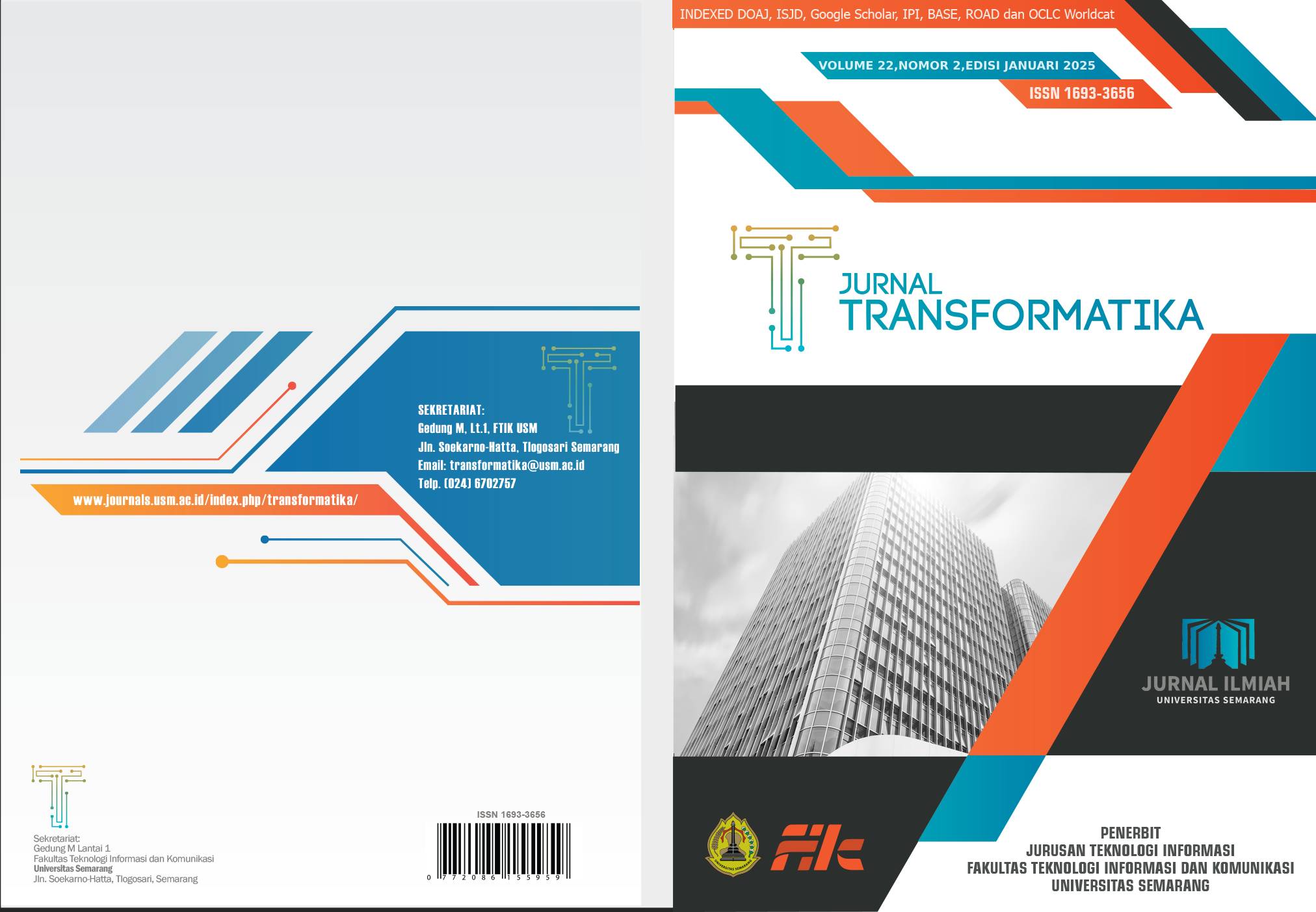Komparasi Metode SVM dan Adaboost untuk Klasifikasi Kanker Payudara
DOI:
https://doi.org/10.26623/9adm2e13Keywords:
Adaboost, SVM, Klasifikasi, Kanker PayudaraAbstract
One of the most prevalent malignancies in women and a major global cause of death is breast cancer. To determine whether a cancer is benign or malignant, early detection is essential. The usefulness of the Support Vector Machine (SVM) and Adaptive Boosting (Adaboost) algorithms for breast cancer classification using mammography data is compared in this study. 569 records make up the dataset, which was sourced from the Kaggle Repository and is split into 75% training data and 25% testing data. Preprocessing steps include feature and target variable creation, categorical-to-numerical conversion, data splitting, and normalization. SVM achieved an accuracy of 97%, with a precision of 98%, recall of 94%, and F1 score of 96%. Adaboost, on the other hand, achieved an accuracy of 96%, precision of 98%, recall of 92%, and F1 score of 95%. The results reveal that both algorithms are highly effective for breast cancer detection, with SVM marginally exceeding Adaboost in total performance. These findings emphasize the promise of machine learning techniques in facilitating early cancer diagnosis, hence boosting survival rates. It is advised that future research employ a wider range of datasets and investigate different classification techniques in order to improve accuracy and dependability even more.
References
J. KUSUMA, B. H. HAYADI, W. WANAYUMINI, and R. ROSNELLY, “Komparasi Metode Multi Layer Perceptron (MLP) dan Support Vector Machine (SVM) untuk Klasifikasi Kanker Payudara,” MIND J., vol. 7, no. 1, pp. 51–60, 2022, doi: 10.26760/mindjournal.v7i1.51-60.
R. Resmiati and T. Arifin, “Klasifikasi Pasien Kanker Payudara Menggunakan Metode Support Vector Machine dengan Backward Elimination,” Sistemasi, vol. 10, no. 2, p. 381, 2021, doi: 10.32520/stmsi.v10i2.1238.
D. Alfiani, M. P. Putri, and W. Widayanti, “Literature Study: Obesitas sebagai Faktor Risiko pada Kanker Payudara Triple Negative,” Bandung Conf. Ser. Med. Sci., vol. 2, no. 1, 2022, doi: 10.29313/bcsms.v2i1.760.
K. Khadijah and R. Kusumaningrum, “Ensemble Classifier untuk Klasifikasi Kanker Payudara,” It J. Res. Dev., vol. 4, no. 1, pp. 61–71, 2019, doi: 10.25299/itjrd.2019.vol4(1).3540.
H. Sundari, M. A. Amrustian, A. Dwi, and P. Wicaksono, “Penerapan Recursive Feature Elimination pada Support Vector Machine untuk Klasifikasi Kanker Payudara,” vol. 8798, pp. 60–65, 2024.
N. R. Muntiari and K. H. Hanif, “Klasifikasi Penyakit Kanker Payudara Menggunakan Perbandingan Algoritma Machine Learning,” J. Ilmu Komput. dan Teknol., vol. 3, no. 1, pp. 1–6, 2022, doi: 10.35960/ikomti.v3i1.766.
R. T. Febianto, D. Suranti, and R. T. Alinse, “Penerapan Algoritma Adaboost Dalam Mengetahui Pola Pengguna Kb Di Puskesmas Tanjung Harapan,” J. Sci. Soc. Res., vol. 4307, no. 1, pp. 145–155, 2024.
M. Siddik Hasibuan and H. Harahap, “Penerapan Metode Haar-Like Feature Dan Algoritma Adaboost Dalam Penentuan Klasifikasi Hama Tanaman Kopi,” J. Sci. Soc. Res., vol. 4307, no. 1, pp. 87–93, 2024.
G. Abdurrahman, “Jurnal Sistem dan Teknologi Informasi Klasifikasi Penyakit Diabetes Melitus Menggunakan Adaboost Classifier,” JUSTINDO (Jurnal Sist. dan Teknol. Informasi), vol. 7, no. 1, pp. 59–66, 2022.
R. A. Wati, H. Irsyad, and M. E. A. R. Rivan, “Klasifikasi Pneumonia Menggunakan Metode Support Vector Machine,” J. Algoritm., vol. 1, no. 1, pp. 21–32, 2020.
Y. Fatman, N. Khoirun Nafisah, and P. Bendoro Jembar Pambudi, “Implementasi Payment Gateway dengan Menggunakan Midtrans pada Website UMKM Geberco,” J. KomtekInfo, vol. 10, pp. 64–72, 2023, doi: 10.35134/komtekinfo.v10i2.364.
Marthin Luter Laia and Yudi Setyawan, “Perbandingan Hasil Klasifikasi Curah Hujan Menggunakan Metode SVM dan NBC,” J. Stat. Ind. dan Komputasi, vol. 5, no. 2, pp. 51–61, 2020.
Y. Amrozi, D. Yuliati, A. Susilo, N. Novianto, and R. Ramadhan, “Klasifikasi Jenis Buah Pisang Berdasarkan Citra Warna dengan Metode SVM,” J. Sisfokom (Sistem Inf. dan Komputer), vol. 11, no. 3, pp. 394–399, 2022, doi: 10.32736/sisfokom.v11i3.1502.
M. Arief, “Klasifikasi Kematangan Buah Jeruk Berdasarkan Fitur Warna Menggunakan Metode SVM,” J. Ilmu Komput. dan Desain Komun. Vis., vol. 4, no. 1, pp. 9–16, 2019.
L. Qadrini, A. Sepperwali, and A. Aina, “Decision Tree Dan Adaboost Pada Klasifikasi Penerima Program Bantuan Sosial,” J. Inov. Penelit., vol. 2, no. 7, pp. 1959–1966, 2021.
A. Byna and M. Basit, “Penerapan Metode Adaboost Untuk Mengoptimasi Prediksi Penyakit Stroke Dengan Algoritma Naïve Bayes,” J. Sisfokom (Sistem Inf. dan Komputer), vol. 9, no. 3, pp. 407–411, 2020, doi: 10.32736/sisfokom.v9i3.1023.
D. Pramadhana, “Klasifikasi Penyakit Diabetes Menggunakan Metode CFS dan ROS dengan Algoritma J48 Berbasis Adaboost,” Edumatic J. Pendidik. Inform., vol. 5, no. 1, pp. 89–98, 2021, doi: 10.29408/edumatic.v5i1.3336.
Downloads
Published
Issue
Section
License
Copyright (c) 2025 Jurnal Transformatika

This work is licensed under a Creative Commons Attribution 4.0 International License.
Authors who publish with this journal agree to the following terms:
- Authors retain copyright and grant the journal right of first publication with the work simultaneously licensed under a Creative Commons Attribution License that allows others to share the work with an acknowledgement of the work's authorship and initial publication in this journal.
- Authors are able to enter into separate, additional contractual arrangements for the non-exclusive distribution of the journal's published version of the work (e.g., post it to an institutional repository or publish it in a book), with an acknowledgement of its initial publication in this journal.
- Authors are permitted and encouraged to post their work online (e.g., in institutional repositories or on their website) prior to and during the submission process, as it can lead to productive exchanges, as well as earlier and greater citation of published work.

Transformatika is licensed under a Creative Commons Attribution 4.0 International License.


